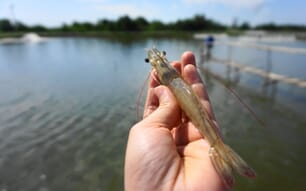
© Anja Striberny, Nofima
Temperature is a master regulator in fish biology, influencing their behaviour, physiology, health, welfare, and growth. Before salmon undergo smoltification (the physiological change that allows them to move from fresh to salt water), temperature is a highly effective tool for managing growth rates.
In recent years, concerns have grown that the temperatures used during rearing may be too high. Possible adverse outcomes include poor heart health. There have also been claims that fast-growing parr (juvenile salmon) may not thrive after transfer to seawater. The Norwegian aquaculture industry sought answers, prompting Nofima scientists to conduct a long term study.
"There was a lack of long-term experiments assessing the effects of temperature from smolt to harvest. We needed this to determine whether high temperatures early in life would impact salmon growth and health later on," said Anja Striberny, scientist at Nofima, in a press release.
The trial and suprising results
Striberny and colleagues set up the experiment at Nofima’s aquaculture research station in Sunndalsøra on the west coast of Norway. Atlantic salmon were followed from 10 grams up to the smolt stage (up to 200 grams), with groups reared in water at 8, 12 or 14 degrees Celsius. To ensure industry relevance, both flow-through and recirculating aquaculture systems (RAS) were tested. Once smoltified, the fish were transferred to the seawater facility at Gildeskål in Northern Norway.
Most initial findings were as expected: all fish developed good seawater tolerance, and survival in seawater was high across all groups. Fish held at higher freshwater temperatures were significantly larger at seawater transfer: the average weight for the 14-degree group was 140 grams, compared to just 70 grams for the eight-degree group.
What surprised the scientists was that, during the sea growth phase, fish from the higher temperature group continued to grow faster than those from the lower temperature groups. It remains unclear if this accelerated sea growth is due to a higher growth rate during smolt production or simply a higher body weight at sea transfer.
Health and quality assessments
While growth and survival were positive, the research team is still analysing tissue samples and investigating molecular responses to look for "invisible" effects. Based on outer welfare indicators, there were only minor differences between the groups. However, there were some negative tendencies observed in the fish that had experienced high temperatures, including a tendency for mild cataracts at the end of the seawater phase, and slightly smaller hearts were also seen in fish reared in RAS.
Furthermore, the team investigated the effect on the final product, as the main objective of salmon farming is food production.
“Interestingly, the 12 and 14-degree groups showed a higher proportion of fish with superior quality, with a tendency towards more intense fillet colour”, said Sven Martin Striberny, head of research.
Context and caution
The Norwegian Seafood Research Fund (FHF) has financed the research. Jørgensen, emphasised that these results must be seen in relation to findings from other projects funded under FHF’s research area “Robust Fish”.
“When several of the projects have delivered their recommendations, it will be important to compile the results so that the aquaculture industry can gain updated knowledge about which early production conditions produce a farmed salmon with the best possible health and performance,” added Jørgensen.
In summary, results from conventional smolt production between 10 and 200 grams show that temperatures up to 14 degrees are themselves unproblematic – and may even be advantageous for long-term performance.
However, Striberny added a word of caution for those who believe higher temperatures guarantee rapid growth in salmon: “We only manipulated temperature in this trial. Density and water quality were kept well within recommended levels, and changes to those parameters could produce different results.”
The research was conducted in the project Temp-Intens in collaboration with the Arctic University of Norway, University of Bergen, Norwegian University of Science and Technology, Mowi, Grieg Seafood and Cermaq.




